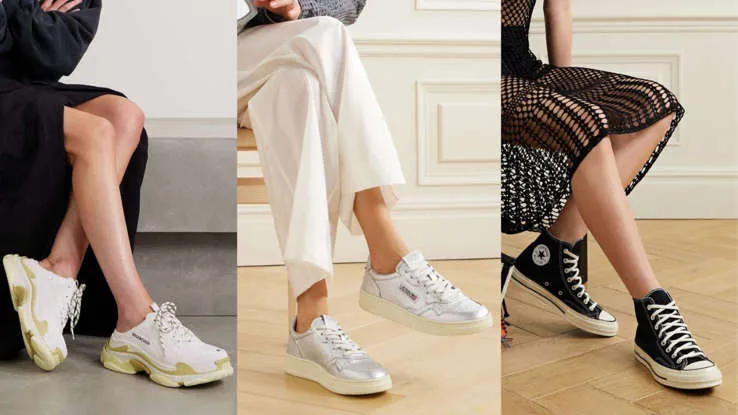Sneakers 2025 Trends You Need to Know to Stay Ahead in Style

Sneakers 2025 are revolutionizing the footwear industry by seamlessly blending advanced technology, sustainability, and innovative design. The shoe market is adjusting to add products that are attractive, increase performance, and help reduce harm to the planet. The article discusses the latest trends, materials, and technologies changing sneakers in five years and why they change our expectations of footwear.
Tech Innovations
Technology in sneakers 2025 is advancing at an unprecedented rate. These systems track your movements by sensor and instantly adapt the comfort level of the sole as you go. The heart rate, steps, and calories you burn are monitored by embedded biometric sensors, which pair with your mobile phone and fitness apps to give you clear health information.
3D printing allows brands in the industry to design custom fits according to data from foot scans, wasting less material and increasing their customers’ comfort. Adding graphene to the soles makes them stronger and more flexible while keeping them lightweight. In addition, some running shoes have kinetic energy harvesting, which uses the body’s movement to charge smart functions and keep the shoes independent of batteries.
Fitting shoes are entering the market. These shoes use sensors to alter the lacing under swelling or during active movement. Users can send commands to the sneaker’s AI assistant or use voice controls to set up their shoes differently.
Sustainable Materials
Sustainability is no longer optional—it is central to the design of sneakers in 2025. Firms are now featuring environmental materials in their products to reduce the amount of carbon they emit. Uppers made from recycled ocean plastics contribute to high durability, and algae midsoles give the same support; only now are they biodegradable.
Synthetic mushroom leather and plant-based materials look just as they would and are gentle to the planet and animals. You can find shoe companies that recycle used sneakers, which helps make new pairs with much less waste.
New methods of dyeing minimize the use of water and dangerous chemicals. Companies producing sneakers with renewable energy and setting high ethical labor requirements ensure everything is done properly. These efforts make sneakers 2025 a beacon for sustainable fashion innovation.
Design Trends
The design of sneakers 2025 marries function with bold aesthetics. Designers use today’s advanced materials and sheet glass to highlight the components inside the watch. When light changes, these materials react and glimmer with a moving effect.
Lights placed on shoes can be adjusted, so users can control the light’s design and colors using their mobile phones. Reflective materials help runners and cyclists stay seen at night because they will be more visible.
When sneaker firms, visual artists, and technological companies unite, creativity and rarity increase. Often, Nike releases limited editions with augmented reality, unlockable on a smartphone, to let people see their sneakers in action online.
Making a design your own is now easier than it used to be. Sports sneakers can be made special by choosing from different colors, mixed materials and included technologies using straightforward apps.
AI and Data
Artificial intelligence will transform product development and customer experience for sneakers in 2025. It will use information about consumers’ feet and shoe wear to help develop sneakers with a better fit and greater durability.
In stores, AI tools use smartphone AR to show customers the shoes on their feet right away, making it easier for them to choose and shop with confidence. Thanks to AI, personalized marketing can advise sneaker purchases based on a customer’s previous style choices, the amount of exercise performed, and what was bought before.
Thanks to data analytics, inventory can be controlled, so companies make and store only the needed amount. When brands rely on predictive algorithms, they can introduce new collections that match today’s changing fashion trends.
Performance Focus
In 2025, sneakers are advancing fast because performance is still at the heart of their innovation. Sportotion shoes use newly created midsoles made from plants to give a better bounce back and save your legs from shock. Since the Trails React sole responds to hardness, movement and what you are doing, it benefits both runners and athletes.
Breathable, specially designed uppers remove sweat and give needed support to help you feel less tired. Lacing systems that adjust smartly help keep your feet comfortable and stop you from constantly getting pressure spots.
Technology using nanoparticles allows the traction soles to grip the ground differently in different situations, from outside on wet surfaces to indoor conditions. Sensors detected in athletic shoes report data on how and where you strike your foot, how much force there is, and which training apps adjust your training to improve and prevent injuries.
Culture & Collecting
Sneaker culture flourishes when it is exclusive, innovative, and about community. When paired with NFTs, physical sneakers now bring additional value and opportunities for those passionate about them. With these authenticated digital properties, collectors can confirm their ownership, join in special events virtually, and access the brand’s first offerings.
Since social media is widely available, trends and the spread of hype are becoming more frequent online. People and companies with early access to collections are anxious, as automated tools help resellers track demand. Besides shoes you can wear, sneakers also reflect people’s status and are considered investments.
Groups that value sneaker culture help fans and industry leaders share art and ideas to affect mainstream fashion. Meetups and conventions improve the entire experience by adding physical and digital parts.
Sneakers 2025 symbolizes a new era of footwear that transcends traditional expectations. They use the newest technology, eco-friendly materials, and design choices that fit with different cultures to make products that are smart, friendly to the environment, and trendy. Whether you need them for running, casually wearing, or collecting, these sneakers are what responsible consumers are looking for today.
Because of these two elements, sneakers will improve, last longer, and have even greater value for who we are. To outperform in this growing industry, you must be curious about the shifts steering sneaker trends forward.
FAQs
What materials are used in sneakers 2025?
Sneakers in 2025 use recycled plastics, algae-based foams, mushroom leather, and graphene-infused polymers to balance durability with sustainability.
How does AI improve sneakers?
AI personalizes fit, recommends styles based on data, enables virtual try-ons, and helps brands forecast demand for better production planning.
Are sneakers customizable in 2025?
Yes, customization options include colors, materials, tech features, and personalized fit adjustments available through digital platforms.
How sustainable are sneakers 2025?
Highly sustainable, with closed-loop recycling, biodegradable materials, renewable energy production, and water-saving processes.
What new performance features do sneakers have?
Smart cushioning, adaptive soles, automatic lacing, breathable engineered fabrics, and embedded sensors provide enhanced comfort, support, and real-time training feedback.








